
The Marasmiaceae are a family of basidiomycete fungi which have white spores. They mostly have tough stems and the capability of shrivelling up during a dry period and later recovering. The widely consumed edible fungus Lentinula edodes, the shiitake mushroom, is a member of this family. According to a 2008 estimate, the family contains 54 genera and 1590 species.

The Hygrophoraceae are a family of fungi in the order Agaricales. Originally conceived as containing white-spored, thick-gilled agarics, including Hygrophorus and Hygrocybe species, DNA evidence has extended the limits of the family, so it now contains not only agarics, but also basidiolichens and corticioid fungi. Species are thus diverse and are variously ectomycorrhizal, lichenized, associated with mosses, or saprotrophic. The family contains 25 genera and over 600 species. None is of any great economic importance, though fruit bodies of some Hygrocybe and Hygrophorus species are considered edible and may be collected for sale in local markets.

Hygrocybe is a genus of agarics in the family Hygrophoraceae. Called waxcaps in English, basidiocarps are often brightly coloured and have waxy to slimy caps, white spores, and smooth, ringless stems. In Europe they are characteristic of old, unimproved grasslands which are a declining habitat, making many Hygrocybe species of conservation concern. Elsewhere they are more typically found in woodlands. Most are ground-dwelling and all are believed to be moss associates. Around 150 species are recognized worldwide. Fruit bodies of several Hygrocybe species are considered edible and are sometimes offered for sale in local markets.

The Tricholomataceae are a large family of mushrooms within the Agaricales. Originally a classic "wastebasket taxon", the family included any white-, yellow-, or pink-spored genera in the Agaricales not already classified as belonging to e.g. the Amanitaceae, Lepiotaceae, Hygrophoraceae, Pluteaceae, or Entolomataceae.
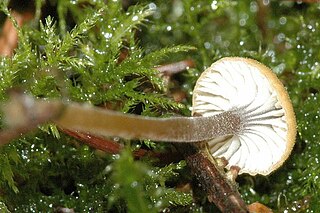
Rickenella is a genus of brightly colored bryophilous agarics in the Hymenochaetales that have an omphalinoid morphology. They inhabit mosses on mossy soils, peats, tree trunks and logs in temperate regions of both the Northern and Southern Hemispheres. Phylogenetically related agarics are in the genera Contumyces, Gyroflexus, Loreleia, Cantharellopsis and Blasiphalia, as well as the stipitate-stereoid genera Muscinupta and Cotylidia. and the clavarioid genus, Alloclavaria.

Gerronema is a genus of small- to medium-sized lignicolous agarics with white, nonamyloid, spores and decurrent gills. The genus was circumscribed by American mycologist Rolf Singer in 1951.
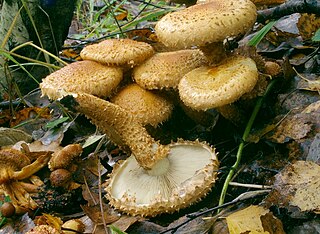
Pholiota is a genus of small to medium-sized, fleshy mushrooms in the family Strophariaceae. They are saprobes that typically live on wood. The genus has a widespread distribution, especially in temperate regions, and contains about 150 species.

The Inocybaceae are a family of fungi in the order Agaricales. Members of this family have a widespread distribution in tropical and temperate areas.
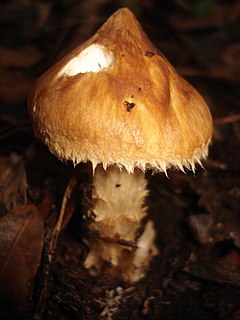
Squamanita is a parasitic genus of agaric fungi formerly classified in the family Tricholomataceae and is now in the Cystodermateae in the Squamanitaceae. The fruitbodies of this genus resemble a normal agaric but they emerge from parasitized fruitbodies of other agarics that Squamanita has deformed. The deformation may be massive and the host may then resemble a lump, or the deformation may be so subtle that the Squamanita appears to be grafted onto the stipe of the host that nearly always fails to form a pileus. Because of the seamless graft-like attachment or the severe deformation of the host into a nonrecognizable blob, early descriptions included features of the host in descriptions of Squamanita as if they were parts of the parasite. This error led to the creation of a separate subgenus because of misinterpretation of host veil tissue as part of the parasite and ultimately a separate genus, Dissoderma. Serendipitous discovery of one parasitized host fruitbody (Galerina) that formed its own pileus that then bore three Squamanita contortipes fruitbodies revealed the parasitic nature of the relationship for that species and the entire genus. This discovery was so shocking that it was featured in Nature magazine under the title 'Mycological mystery tour'. Once the parasitic nature was revealed, the term 'protocarpic tuber' used by earlier authors for the parasitized host base was replaced by the term 'cecidiocarp'.
Semiomphalina is a basidiolichen genus in the family Hygrophoraceae. The genus is monotypic, containing the single species Semiomphalina leptoglossoides, found in Papua New Guinea.

Chromosera cyanophylla is a species of fungus in the genus Chromosera. It is the type species of Chromosera.

Meinhard Michael Moser was an Austrian mycologist. His work principally concerned the taxonomy, chemistry, and toxicity of the gilled mushrooms (Agaricales), especially those of the genus Cortinarius, and the ecology of ectomycorrhizal relationships. His contributions to the Kleine Kryptogamenflora von Mitteleuropa series of mycological guidebooks were well regarded and widely used. In particular, his 1953 Blätter- und Bauchpilze [The Gilled and Gasteroid Fungi ], which became known as simply "Moser", saw several editions in both the original German and in translation. Other important works included a 1960 monograph on the genus Phlegmacium and a 1975 study of members of Cortinarius, Dermocybe, and Stephanopus in South America, co-authored with the mycologist Egon Horak.

Nivatogastrium is a genus of secotioid fungi in the family Strophariaceae. The genus has contained four species found in North America and New Zealand, but the type species is now considered to be a gasteroid species of Pholiota, and was transferred to that genus in 2014.
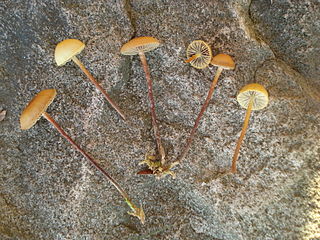
Bogbodia is a bog-inhabiting agaric fungal genus that colonizes peat and Sphagnum and produces tan-colored fruit bodies. The only species in the genus is Bogbodia uda. Characteristically it forms chrysocystidia and rather large, finely roughened, violaceous basidiospores each with a poorly defined germ pore. The genus differs from Hypholoma which has smaller, smooth basidiospores and typically have cespitose fruit bodies and decay wood. Phylogenetically, Bogbodia is distinct from Hypholoma, Pholiota, and Leratiomyces.

Mycopan is one of several genera of agaric fungi (mushrooms) that were formerly classified in the genus Hydropus or Mycena. Mycopan is currently monotypic, containing the single species Mycopan scabripes. It produces dusky colored fruit bodies that are mycenoid, but lack amyloid or dextrinoid tissues except for the amyloid basidiospores. Its stipe is notably scruffy from cystidioid end cells and unlike true Hydropus it does not bleed clear fluid. Phylogenetically, Mycopan is distant from the Mycenaceae and the type of that family, Mycena, and it is not with the type of Hydropus, Hydropus fuliginarius. Mycopan grouped closest to Baeospora. Baeospora was shown to be in the Cyphellaceae by Matheny and colleagues. Mycopan scabripes grows from debris in forest floors in North America and Europe.

The Porotheleaceae are a family of saprophytic, mainly wood-decay fungi in the order Agaricales that are primarily agarics, but also include cyphelloid and polyporoid members. The family had been informally cited in the literature as the 'hydropoid' clade. The type genus, Porotheleum, was placed in the phylogenetically defined clade in 2002 but the clade was more strongly supported in 2006 but without including Porotheleum. Its sister group is the Cyphellaceae, both in the 'marasmioid clade'. Some included taxa are cultivated by ants. More recently the family was recognized in an analysis that included Porotheleum.

Eonema is a fungal genus in the family Hygrophoraceae. It is monotypic, consisting of the single corticioid species Eonema pyriforme. This fungus was previously classified in the genus Athelia until molecular analysis demonstrated that it was unrelated to the Atheliales and instead nested within the Hygrophoraceae.
Flammula is a dark brown-spored genus of mushrooms that cause a decay of trees, on whose bases they often fruit, forming clusters of yellowish brown mushrooms.
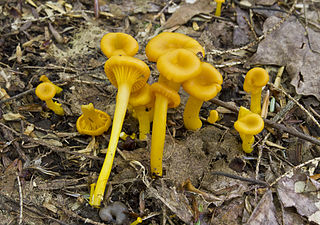
Gloioxanthomyces is a genus of fungi in the family Hygrophoraceae. It was circumscribed in 2013 to contain G. nitidus, and the type species, G. vitellinus. Within the Hygrophoracae, it is in the tribe Chromosereae and closely related to the genus Chromosera. The generic name derives from the Greek gloio ("glutinous"), xantho ("yellow"), and myces (fungus).

















